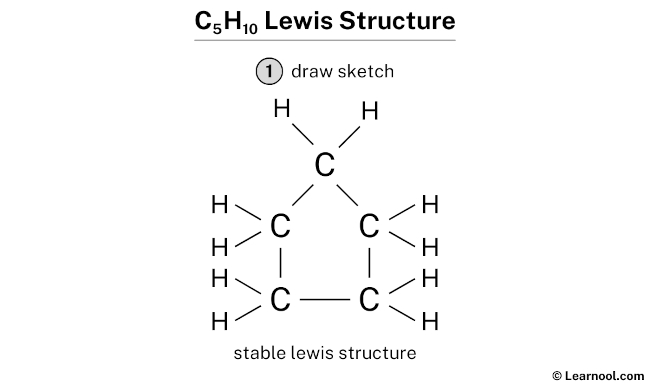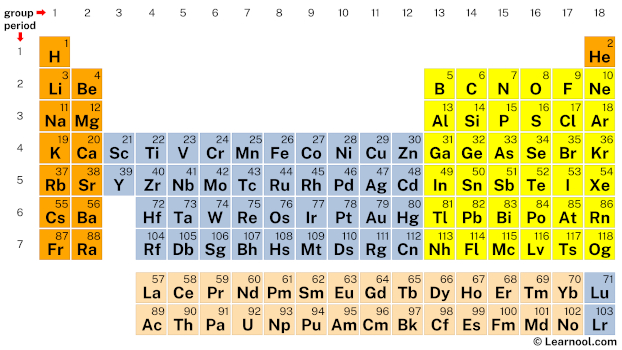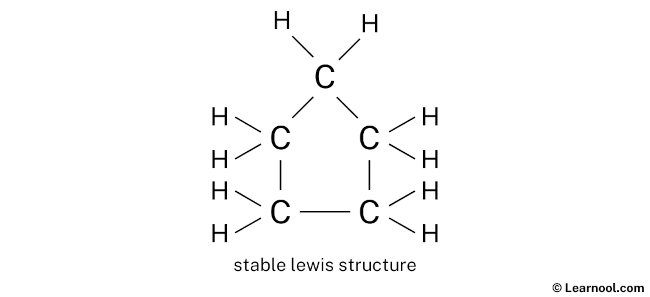
C5H10 (cyclopentane) has five carbon atoms and ten hydrogen atoms.
In C5H10 Lewis structure, there are five single bonds between the five carbon atoms, and each carbon is attached with two hydrogen atoms. And none of the atoms has a lone pair.
Alternative method: Lewis structure of C5H10
Steps
To properly draw the C5H10 Lewis structure, follow these steps:
#1 Draw a rough sketch of the structure
#2 Next, indicate lone pairs on the atoms
#3 Indicate formal charges on the atoms, if necessary
Let’s break down each step in more detail.
#1 Draw a rough sketch of the structure
- First, determine the total number of valence electrons

In the periodic table, carbon lies in group 14, and hydrogen lies in group 1.
Hence, carbon has four valence electrons and hydrogen has one valence electron.
Since C5H10 has five carbon atoms and ten hydrogen atoms, so…
Valence electrons of five carbon atoms = 4 × 5 = 20
Valence electrons of ten hydrogen atoms = 1 × 10 = 10
And the total valence electrons = 20 + 10 = 30
Learn how to find: Carbon valence electrons and Hydrogen valence electrons
- Second, find the total electron pairs
We have a total of 30 valence electrons. And when we divide this value by two, we get the value of total electron pairs.
Total electron pairs = total valence electrons ÷ 2
So the total electron pairs = 30 ÷ 2 = 15
- Third, determine the central atom
Here hydrogen can not be the central atom. Because the central atom is bonded with at least two other atoms, and hydrogen has only one electron in its last shell, so it can not make more than one bond.
Now there are five atoms remaining and all five atoms are carbon, so we can assume any one as the central atom.
Let’s assume that the central atom is top carbon.
Therefore, place carbons in the center and hydrogens on either side.
- And finally, draw the rough sketch

#2 Next, indicate lone pairs on the atoms
Here, we have a total of 15 electron pairs. And fifteen bonds are already marked. So we do not have to mark any electron pair as a lone pair on the sketch.
In the above structure, you can see that the central atom (top carbon) forms an octet. The outside atoms (other carbons) also form an octet, and all hydrogens form a duet. Hence, the octet rule and duet rule are satisfied.
Therefore, this structure is the stable Lewis structure of C5H10.
Next: IBr4– Lewis structure
External video
- How to Draw the Lewis Dot Structure for C5H10: Cyclopentane – YouTube • Wayne Breslyn
External links
- https://www.reddit.com/r/chemhelp/comments/qjt7z0/what_is_the_lewis_structure_and_3d_drawing_of/
- https://www.chegg.com/homework-help/questions-and-answers/draw-lewis-structure-c5h10-q16933075
- https://oneclass.com/homework-help/chemistry/7026800-c5h10-lewis-structure.en.html
- https://brainly.com/question/30157038
Deep
Learnool.com was founded by Deep Rana, who is a mechanical engineer by profession and a blogger by passion. He has a good conceptual knowledge on different educational topics and he provides the same on this website. He loves to learn something new everyday and believes that the best utilization of free time is developing a new skill.
